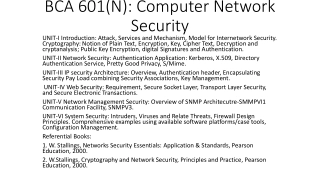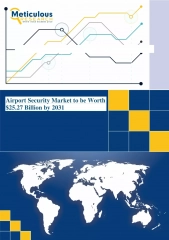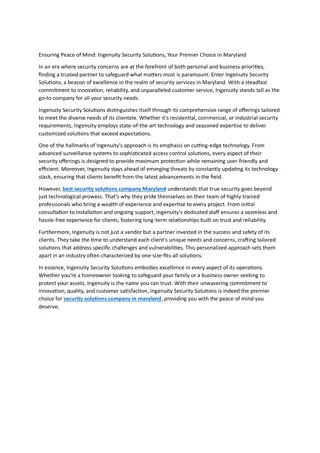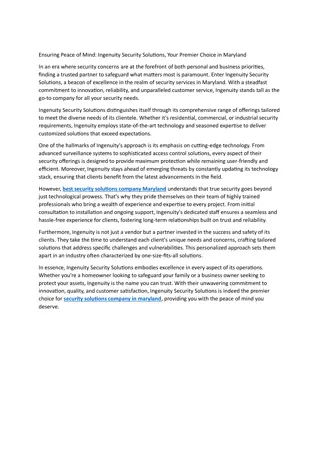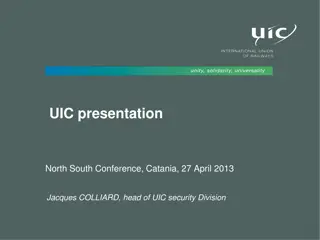Introduction to Security
The threats to computer networks is crucial in today's digital age. Learn about malware, spyware, viruses, worms, trojan horses, botnets, denial-of-service attacks, packet sniffing, and more. Explore the evolution of network security and the measures to defend against malicious attacks that can disrupt daily operations. Stay informed to protect your systems and data from cyber threats.
Uploaded on Feb 15, 2025 | 0 Views
Download Presentation

Please find below an Image/Link to download the presentation.
The content on the website is provided AS IS for your information and personal use only. It may not be sold, licensed, or shared on other websites without obtaining consent from the author.If you encounter any issues during the download, it is possible that the publisher has removed the file from their server.
You are allowed to download the files provided on this website for personal or commercial use, subject to the condition that they are used lawfully. All files are the property of their respective owners.
The content on the website is provided AS IS for your information and personal use only. It may not be sold, licensed, or shared on other websites without obtaining consent from the author.
E N D
Presentation Transcript
Introduction to Security Computer Networks Term A15
Intro to Security Outline Network Security Malware Spyware, viruses, worms and trojan horses, botnets Denial of Service and Distributed DOS Attacks Packet Sniffing Masquerading Attacks Man-in-the-Middle Attacks Computer Networks Introduction to Security 2
Networks under Attack The original Internet (i,e., ARPANET) was not designed with security in mind. The early vision was a group of mutually trusting users attached to a transparent network . ARPANET started out as academics and DoD users!! Protocol and application designers are playing catch-up . The Internet changed: Added industrial management partners WWW made the Internet accessible to the masses. Bad guys can attack networks and attempt to wreak havoc on our daily lives. ISP s Computer Networks Introduction to Security 3
Network Security Network security is about: How bad guys can attack computer networks. How we can defend networks against attacks. How to design architectures that are immune to attacks. Network security is becoming more important as more individuals become dependent on the Internet and as the destructive nature of new attacks increases. Security issues exist at all layers! Computer Networks Introduction to Security 4
Malware Malware:: malicious stuff that enters our hosts from the Internet and infects our devices. Spyware collects private information (e.g., keystrokes and web sites visited) and uploads info to bad guy collection sites. An infected host can be enrolled in a botnet, used for spam and distributed denial-of-service (DDoS) attacks. Malware is often self-replicating (i.e., from an infected host, it seeks entry into other hosts). Computer Networks Introduction to Security 5
Malware from the Internet Malware can get into a host and spread in the form of a virus, worm, or trojan horse. Virus:: Requires some form of user active execution. Classic example: an email attachment containing malicious executable code that is triggered when the attachment is opened. Self-replicating (e.g., via address book) Computer Networks Introduction to Security 6
Worms and Trojan Horses Worm Infects by passively receiving object via a vulnerable network application that runs the malware to create worm. Self-replicates by searching for hosts running the same application. Sapphire Worm: aggregate scans/sec in first 5 minutes of outbreak (CAIDA, UWisc data) Trojan horse Hidden in some otherwise useful software. Often found today on a Web page (Active-X, plugin). Computer Networks Introduction to Security 7
Denial-of-Service Attack Denial-of-service (DoS) renders resources (server, link) unusable by legitimate users by overwhelming the resource with bogus traffic. select target 2. break into hosts around the network (see botnet) 3. send packets toward target from compromised hosts 1. target Distributed DoS (DDoS) Computer Networks Introduction to Security 8
Denial-of-Service Attack Three categories: Vulnerability attack:: attack application with well-crafted messages (result service stops or host crashes). Bandwidth flooding:: deluge victim with so many messages such that target s access link gets clogged. Connection flooding:: initiate so many half-open or open TCP connections that target stops accepting legitimate connections. Computer Networks Introduction to Security 9
Bad Guy Packet Sniffing Packet sniffing:: passive receiver that records a copy of every packet that goes by (e.g., Wireshark) broadcast media (shared Ethernet, wireless) promiscuous network interface reads/records all packets (e.g., including passwords!) passing by C A src:B dest:A payload B Computer Networks Introduction to Security 10
Masquerade Attack IP spoofing:: send a packet with false source address C A src:B dest:A payload B Computer Networks Introduction to Security 11
Man-in-the-Middle Attack record-and-playback:: sniff sensitive info (e.g., password), and use later Bad guy password holder is that user from system point of view C A src:B dest:A user: B; password: foo B Computer Networks Introduction to Security 12
Intro to Security Summary Network Security Malware Spyware, viruses, worms and trojan horses, botnets DoS and DDOS Attacks Packet Sniffing (promiscuous mode) Masquerading Attacks (IP spoofing) Man-in-the-Middle Attacks Record and playback Computer Networks Introduction to Security 13


